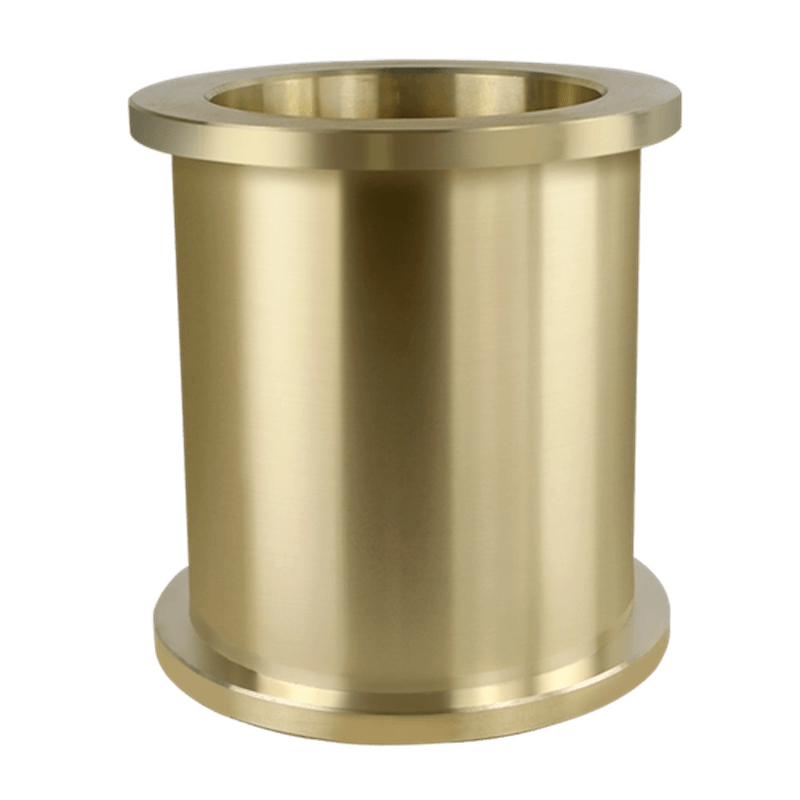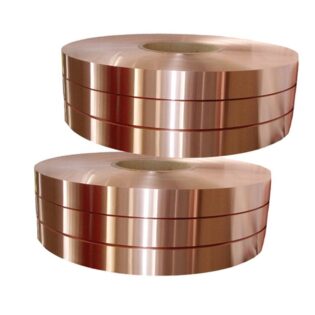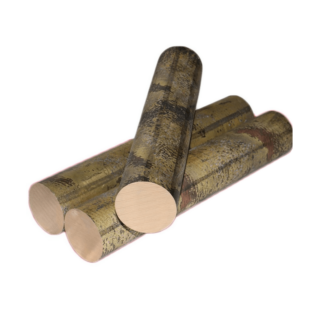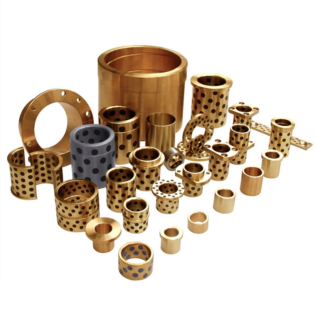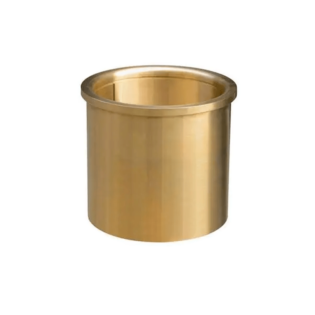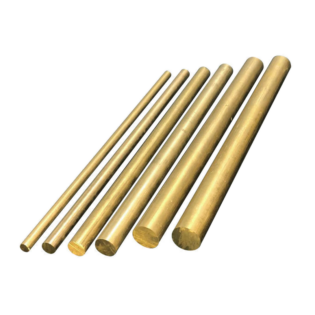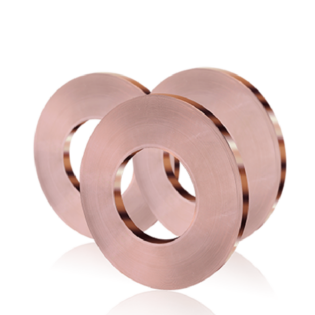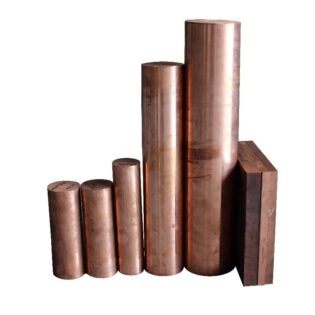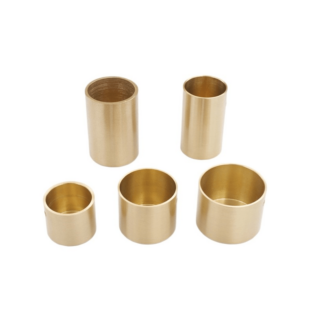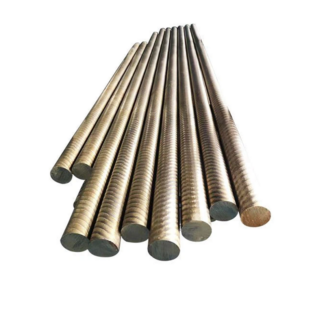AMS 4880-C95510 Nickel Aluminium Bronze Product Introduction
Composition chimique
| Élément | Pourcentage (%) | Rôle dans l'alliage |
|---|
| Avec | 78.00 minutes | Constituant principal, fournit une structure et des propriétés de base |
| ressorts de connecteur | 0.20 maximum | Améliore la résistance à la corrosion et la solidité |
| Zn | 0.30 maximum | Améliore la force et agit comme un désoxydant |
| Fe | 2,00-3.50 | Affine la structure des grains et augmente la résistance |
| Ni | 4.50-5.50 | Améliore la résistance à la corrosion et les propriétés mécaniques |
| Al | 9.70-10.90 | Forme des composés intermétalliques, améliorant la résistance et la résistance à l'usure |
| Mn | 1,50 maximum | Améliore la force et désoxise l'alliage |
Remarque: Cu + somme des éléments nommés, 99,8% min. La valeur NI inclut Co., sauf indication contraire, les valeurs uniques représentent les maximums.
Propriétés mécaniques
| Propriété | Castings <4.0, Heat Treated | Coulages 4.0+, traité thermique |
|---|
| Résistance à la traction, min | 105,0 KSI (724 MPa) | 95,0 KSI (655 MPa) |
| Limite d'élasticité (décalage de 0,2%), min | 62,5 KSI (431 MPa) | 56,0 KSI (386 MPa) |
| Allongement en 4d, min | 9% | 9% |
| dureté Brinell | 192 à 248 BHN | 192 à 248 BHN |
Performances à différentes températures
| Plage de température | Caractéristiques de performance |
|---|
| Températures basses (-50 ° C à 0 ° C) | Maintient une bonne ductilité et de la ténacité |
| Température ambiante (20°C à 25°C) | Équilibre optimal de résistance et de ductilité |
| Températures modérées (100 ° C à 200 ° C) | Conserve une bonne dureté et une résistance à l'usure |
| Températures élevées (200 ° C à 300 ° C) | Légère diminution de la résistance, mais maintient une bonne résistance à la corrosion |
| Températures élevées (300 ° C à 400 ° C) | Réduction des propriétés mécaniques, mais toujours utilisable dans certaines applications |
Applications industrielles
| Secteur de l'industrie | Applications spécifiques |
|---|
| Aérospatial | Bougchons à train d'atterrissage, roulements dans les structures des avions |
| Marin | Hélices, carres de pompes, composants de soupape dans les systèmes d'eau de mer |
| Pétrole et Gaz | Composants de plate-forme offshore, équipement sous-marin |
| Automobile | Bougchons dans les systèmes de suspension, composants de la boîte de vitesses |
| Machinerie industrielle | Porter des assiettes, bagues en machines lourdes |
| Exploitation minière | Composants de la pompe, pièces du système de convoyeur |
| La production d'énergie | Composants de la turbine, sièges de soupape dans les centrales électriques |
Disponibilité de forme et de taille
| Former | Gamme de tailles | Remarques |
|---|
| Solides | 1/2″ à 9″ DE | – |
| Tubes | 1 1/8 ″ à 13 ″ O.D. | Consulter l'usine pour l'épaisseur du mur |
| Rectangulaires | Jusqu'à 15″ | – |
| Longueurs standard | 24 " | Consulter l'usine pour d'autres longueurs |
| Barre de barre | Divers diamètres | Disponible en formes rondes, hexagonales et carrées |
| Plaque | Jusqu'à 6″ d'épaisseur | La largeur et la longueur varient selon l'épaisseur |
| Forgeages | Tailles personnalisées | Fait sur commande en fonction des spécifications |
Normes de production
| Standard | La description |
|---|
| AMS 4880 | Spécification du matériau aérospatial pour le bronze en aluminium nickel |
| ASTMB150 | Spécification standard pour les tiges, barres et formes en bronze d'aluminium |
| ASTM B171 | Spécifications standard pour la plaque et la feuille de cuivre en alliage pour les récipients sous pression, les condenseurs et les échangeurs de chaleur |
| SAEJ461 | Tube échangeur de chaleur en cuivre et en cuivre |
| Mil-b-21230 | Spécifications militaires pour le bronze, l'aluminium |
Normes et notes correspondantes dans différents pays
| Pays/Région | Norme/qualité | Désignation équivalente |
|---|
| Etats-Unis | AMS 4880-C95510 | US C95510 |
| L'Europe | Et 1982-CC333G | CuAl10Ni5Fe4 |
| Japon | Il h5120-cac703 | – |
| Chine | GB / T 5231-QAL9-4 | – |
| Russie | GOST 493-79 BRA9ZH4N4 | – |
| Inde | Est 3091 GRADE 2 | – |
| Australie | Comme 2074-CA953 | – |
Soudage, traitement, polissage, traitement thermique, traitement du froid
Soudage
| Méthode de soudage | Pertinence | Remarques |
|---|
| Gas Tutting Arc Welling (GAW / TI) | Excellent | Méthode préférée pour les soudures de haute qualité |
| Soudage à l'arc métallique à gaz (GMAW / MIG) | Bon | Convient aux composants plus grands |
| Soudage à l'arc métallique protégé (SMAW) | Équitable | Peut être utilisé mais pas préféré |
| Soudage par faisceau d'électrons | Excellent | Pour le soudage de précision dans les applications aérospatiales |
| Soudage par agitation à la friction | Bon | Méthode émergente pour l'adhésion à l'état solide |
Traitement
| Méthode de traitement | Cote d'usinabilité | Remarques |
|---|
| Tournant | 50 (échelle 0-100) | Utilisez des outils en carbure pour les meilleurs résultats |
| Fraisage | 50 (échelle 0-100) | Vides de coupe modérées recommandées |
| Forage | 50 (échelle 0-100) | Utiliser des exercices en acier ou en carbure à grande vitesse |
| Tableau de données pour | Bon | Convient pour atteindre des tolérances étroites |
| Usinage à décharge électrique (EDM) | Excellent | Pour des formes et des profils complexes |
Polissage
| Méthode de polissage | Terminer réalisable | Remarques |
|---|
| Polissage mécanique | Finition miroir | Utiliser des abrasifs progressivement plus fins |
| Électropolissage | Éclat élevé | Convient aux géométries complexes |
| Polissage | Brillant | Étape finale pour les applications décoratives |
Traitement thermique
| Processus de traitement thermique | Plage de température | But |
|---|
| Recuit de solution | 870-900 ° C | Homogénéiser la microstructure |
| Trempe | Refroidissement rapide à température ambiante | Augmente la résistance et la dureté |
| Vieillissement | 350-400 ° C pendant 2 à 4 heures | Améliorer les propriétés mécaniques |
| Soulagement du stress | 350-400 ° C pendant 1 à 2 heures | Réduire les contraintes internes |
Traitement à froid
| Méthode de traitement du froid | Effet sur les matériaux | Applications |
|---|
| Laminage à froid | Augmente la force et la dureté | Production de feuilles et de bandes |
| Étirage à froid | Améliore la finition de la surface et la précision dimensionnelle | Production de fil et de tube |
| Forgeage à froid | Améliore les propriétés mécaniques | Composants de forme proche du réseau |
Avantages et inconvénients des matériaux
Avantages
| Avantage | La description |
|---|
| Haute résistance | Excellente traction et limite d'élasticité par rapport à de nombreux autres alliages de cuivre |
| Résistance à l'usure | Résistance supérieure à l'abrasion et à l'édouement |
| Résistance à la corrosion | Bonne résistance à l'eau de mer et à de nombreux produits chimiques |
| Conductivité thermique | Mieux que les aciers inoxydables, adaptés aux applications d'échange de chaleur |
| Anti-étincelles | Sans danger pour une utilisation dans des environnements explosifs |
| Perméabilité magnétique faible | Convient aux applications nécessitant des matériaux non magnétiques |
Désavantages
| Inconvénient | La description |
|---|
| Coût | Plus cher que des alliages ou des aciers en cuivre plus simples |
| Masse | Plus lourds que les alliages en aluminium, ce qui peut être une préoccupation dans certaines applications |
| Traitement complexe | Nécessite un contrôle minutieux pendant la coulée et le traitement thermique |
| Ductilité limitée | Moins ductile que le cuivre pur ou d'autres alliages de cuivre |
| Potentiel de fissuration de corrosion des contraintes | Peut se produire dans certaines conditions environnementales |
Produits similaires et comparaison
Alliages de bronze en aluminium nickel similaire
| Les propriétés de soudure et de brasage sont excellentes | Composition chimique | Différences clés |
|---|
| C95800 | Cu-9Al-4Fe-4Ni | Contenu en fer plus élevé, légèrement inférieur |
| C95700 | Avec-11al-3fe-5ni | Contenu en aluminium plus élevé, Augmentation de la dureté |
| C95400 | Cu-11Al-4Fe | Pas de nickel, une résistance à la corrosion inférieure |
Comparaison avec d'autres classes de matériel
| Matériel | Avantages par rapport à C95510 | Inconvénients par rapport à C95510 |
|---|
| Acier inoxydable 316 | Coût moindre, plus faible disponibilité | Conductivité thermique plus faible, poids plus élevé |
| Bronze en aluminium (par exemple, C95400) | Moindre coût, plus facile à lancer | Résistance à la résistance et à la corrosion inférieures |
| Bronze phosphoreux | Meilleure conductivité électrique | Résistance à la résistance et à l'usure inférieure |
| Alliages en titane | Ratio de force / poids plus faible et plus élevé | Coût beaucoup plus élevé, plus difficile à machine |
Table de comparaison détaillée
| Propriété | AMS 4880-C95510 | Acier inoxydable 316 | Bronze en aluminium C95400 | Titane grade 5 (Ti-6Al-4V) |
|---|
| Résistance à la traction (MPa) | 655-724 | 515-690 | 586-758 | 895-930 |
| Limite d'élasticité (MPa) | 386-431 | 205-310 | 241-379 | 828-910 |
| Allongement (%) | 9 (min) | 40 | 12 | 10-15 |
| Densité (g/cm³) | 7,64 | 8.00 | 7h45 | 4.43 |
| Conductivité thermique (W/m·K) | 42 | 16.3 | 59 | 6.7 |
| Résistance à la corrosion dans l'eau de mer | Excellent | Excellent | Bon | Excellent |
| Machinabilité (échelle 0-100) | 50 | 50 | 60 | 30 |
| Coût relatif | Haut | Modéré | Modéré | Très haut |
Propriétés et caractéristiques supplémentaires
| Propriété | Valeur | Unités |
|---|
| Résistivité électrique | 14.4 | µΩ·cm |
| La capacité thermique spécifique | 0.375 | J / G · ° C |
| Plage de fusion | 10h30-10h60 | °C |
| Propriétés mécaniques de l'acier à outils AISI HSS M2 | 110-120 | GPa |
| Coefficient de Poisson | 0.33 | – |
| Résistance à la fatigue (cycles 10⁷) | 207-241 | MPa |
| Capacité d'amortissement | Modéré | – |
Considérations environnementales et de recyclage
| Aspect | La description |
|---|
| Recyclabilité | Très recyclable, peut être relâché et réutilisé |
| Impact environnemental | Besoin d'énergie plus faible pour le recyclage par rapport à la production primaire |
| Toxicité | Non toxique en forme solide, mais la poussière et les fumées pendant le traitement doivent être contrôlées |
| Fin de vie | Peut être collecté et recyclé à travers des flux de recyclage métalliques établis |
Méthodes de contrôle et de test de la qualité
| Méthode d'essai | But | Standard |
|---|
| Essais de traction | Déterminer la résistance et la ductilité | ASTM E8 |
| Test de dureté | Mesurer la dureté de surface | ASTM E10 (Brinell) |
| Analyse chimique | Vérifier la composition | ASTM E478 |
| Tests par ultrasons | Détecter les défauts internes | ASTM E114 |
| Tests radiographiques | Inspecter la porosité et les inclusions | ASTM E1742 |
| Tests de corrosion | Évaluer la résistance à la corrosion | ASTM G31 |
Recommandations de stockage et de manutention
| Aspect | Recommandation |
|---|
| Environnement de stockage | Zone sèche et propre loin des produits chimiques |
| Manutention | Utilisez un équipement de levage approprié pour les pièces lourdes |
| Protection | Appliquer des revêtements de protection ou des enveloppements pour éviter les dommages de surface |
| Gestion des stocks | Utilisez le système FIFO (premier dans, premier sorti) pour gérer les actions |
| Précautions de sécurité | Portez des EPI appropriés lors de la manipulation, en particulier pendant la coupe ou l'usinage |
Délai d'exécution typique et facteurs de tarification
| Facteur | La description |
|---|
| Tailles de stock standard | Généralement disponible avec un délai de 1 à 2 semaines |
| Tailles / formes personnalisées | Peut nécessiter un délai de 4 à 8 semaines |
| Quantité | Les commandes plus importantes peuvent avoir des délais plus longs mais de meilleurs prix |
| Conditions du marché | Les prix du cuivre et du nickel peuvent affecter considérablement le coût final |
| Exigences de certification | Les certifications spéciales peuvent augmenter le délai et le coût |
Conclusion
AMS 4880-C95510 Le bronze en aluminium nickel est un alliage haute performance qui offre une excellente combinaison de résistance, de résistance à l'usure et de résistance à la corrosion. Sa polyvalence le rend adapté à un large éventail d'applications dans diverses industries, en particulier dans les environnements marins et aérospatiaux. Bien qu'il puisse avoir un coût initial plus élevé par rapport à certains autres matériaux, ses performances à long terme et sa durabilité entraînent souvent des coûts de cycle de vie plus faibles pour les composants critiques. La capacité du matériau à maintenir ses propriétés dans diverses conditions de fonctionnement, couplées à ses caractéristiques non scolaires, en fait un choix préféré pour les applications critiques de sécurité. Comme pour tout matériau spécialisé, une considération appropriée doit être accordée à la conception, au traitement et à la maintenance pour tirer pleinement parti de ses capacités et assurer des performances optimales tout au long de sa durée de vie.
